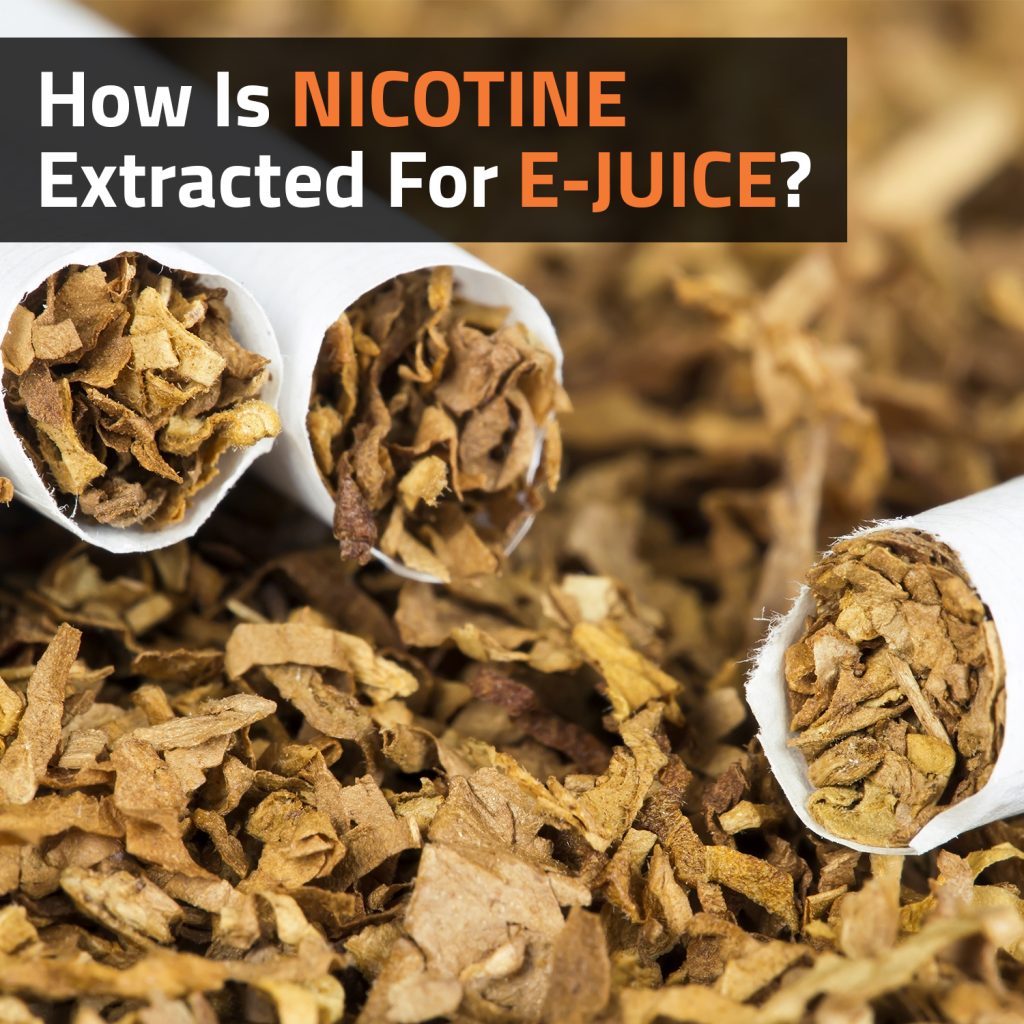Have you ever wondered exactly where the nicotine in your vape juice comes from, or how it is extracted? As science has progressed, there is no need for e-liquids to contain tobacco-derived ingredients, making it safer than smoking but just as effective at satisfying nicotine cravings. Let’s take a look at where the nicotine contained in vape juice comes from.
How Did Nicotine Extraction Begin?
The process of nicotine extraction from tobacco began with various tobacco companies conducting research in the 1960s. Their aim was to answer the following questions:
- How can the amount of tobacco in cigarettes be reduced without producing an under-filled cigarette?
- How can we utilise the ribs and stems of the tobacco plant to avoid wasting these parts or selling unenjoyable cigarettes?
- How can the demand for lower-tar and lower-nicotine cigarettes be satisfied while still creating a satisfying product?
The main answer to these questions turned out to be ammonia. These companies created reconstituted tobacco sheets by grinding tobacco leaves, ribs, and stems together. This paste is then processed with ammonia, allowing tobacco to release pectin. Pectin helped to make the mixture turn into sturdy sheets, which can be shredded and filled up into cigarettes.
So, why is this research important? It is important because it essentially led to the discovery of freebase nicotine. This form of nicotine is much more bioavailable than salt-based nicotine, which is a natural component of the tobacco leaf. Tobacco companies could now create cigarettes with lower nicotine levels, while maintaining nicotine satisfaction.
These processes lead to the discovery that ammonia, a potent solvent and alkaline pH adjuster, is very useful in processing tobacco to extract pharmaceutical-grade nicotine. This would become very useful in the future when used to extract nicotine for e-liquids.
What Kind Of Nicotine Does E-Liquid Contain?
Nicotine contained in e-liquids is the same type of nicotine that is used in most other nicotine replacement products. This type of nicotine is classified as pharmaceutical-grade nicotine, which means that your e-liquid contains nicotine that is at least 99% pure. Tobacco products are known to cause damage to all the organs in the body and acts as a carcinogen, so the nicotine that is found in e-liquids is much safer for consumption.
There are three main types of e-liquids that can be distinguished from each other by their extraction processes and the resulting nicotine substances. These types of nicotine include:
- Freebase Nicotine
- Nicotine Salts
- Synthetic Nicotine
How Is Freebase Nicotine Extracted?
To extract any type of substance from plant materials, you will need a solvent. This will force the plant to release all of its constituent components. Nicotine Salt is a natural component of the tobacco leaf, so a chemical that can release the nicotine from its salt is necessary. Lime is good enough to do the job, but ammonia is much more common for mass production.
Once you expose tobacco to a solvent, the resulting product will be a wet mixture of tobacco leaves and the solvent. In order to separate tobacco extracts from the solvent, the mixture needs to be boiled so that the constituent tobacco components will evaporate and leave the solvents behind. By collecting the vapour and letting it condense in a separate container, a raw tobacco distillate will be left behind.
However, tobacco distillate is not the end goal – in order to get pharmaceutical-grade nicotine, the nicotine still needs to be separated from the tobacco distillate. This can be accomplished by using a kerosene or hexane solvent. Once the solvent is boiled out, the end result is pure freebase nicotine.
Since freebase nicotine is necessary for companies that produce nicotine replacement products such as patches or gums, pharmaceutical companies perform nicotine extraction in bulk. Companies that produce freebase e-liquids make use of this freebase nicotine as well, making e-liquids more affordable than they would be if each company would have to perform extraction by themselves.
How Is Nicotine Salt Extracted?
Nic Salts actually originate from standard freebase nicotine e-liquids. Nic Salts are created by adding an acid that triggers chemical reactions and adjusts the pH of the mixture. Since ammonia is a powerful pH adjuster that makes freebase nicotine alkaline, adding some benzoic acid to the mixture reverses that process and produces nicotine with a pH that is close to neutral.
It is the addition of the acid that makes Nic Salts so special – the alkaline pH of freebase nicotine may be an issue for some vapers since it is more likely to cause throat irritation, especially in smaller devices such as pod systems.
Since many vapers prefer smaller devices, they need an e-liquid with a nicotine strength of at least 50 mg/ml in order for your vaping experience to provide an efficient nicotine delivery, especially if they are ex-smokers. Freebase liquids that have a nicotine strength above 18 ml/mg tend to cause quite a bit of throat irritation.
Since Nicotine Salts have a more neutral pH, they do not cause the same kind of irritation. This makes Nicotine Salts perfect for those who are new to vaping, as well as ex-smokers who need as much nicotine as they can get. Although existing vapers may not need higher nicotine concentrations than they are used to, it is a great option for new vapers and ex-smokers.
How Is Synthetic Nicotine Made?
For the most part, the nicotine for e-liquid has been derived from tobacco. However, new developments have shown that synthetic nicotine, which is completely free of tobacco, will take over the e-liquid platform. This type of nicotine has no connection to tobacco in any form (and is also known as Tobacco Free Nicotine), but the resulting products are so expensive that they have not yet been incorporated into e-liquids.
Due to the demand for non-tobacco related nicotine, scientists have been developing methods that are much more economical, increasing the possibility of finding synthetic nicotine in e-liquids in the near future. The methods for creating synthetic nicotine are very complex, and many scientists are keeping their processes secret to avoid competitors from using them.
Essentially, the process involves using a molecule that would be a precursor to nicotine and exposing it to a chemical that triggers a reaction to create nicotine. Nicotine must then be removed from the solution through fractional distillation or by using a solvent to make nicotine crystallise. This results in a molecule that is extremely pure and has no relation to tobacco in any form.
The nicotine found in your vape juice is roughly 99% pure, making it pharmaceutical-grade nicotine, provided that you purchase from a reputable source. Nicotine extracted from the tobacco plant is much safer than using it in conjunction with other elements of the plant. Furthermore, vaping is a much more effective method to quit smoking than any other nicotine replacement product and is much cheaper in the long run. You can be rest assured that all the e-liquids found at Vaperite are of the highest quality and provide a safe and enjoyable vaping experience.






